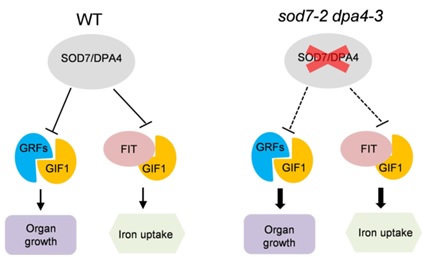Seed and organ size is controlled by both intrinsic genetic factors and external environmental signals. However, the molecular mechanisms that coordinate plant organ growth and nutrient supply remain largely unknown.
To understand the molecular mechanisms for coordinating organ growth and iron uptake in Arabidopsis, research teams led by Prof. SONG Xianjun from the Institute of Botany of the Chinese Academy of Science (CAS), Prof. LI Yunhai and Prof. LING Hongqing from the Institute of Genetics and Developmental Biology of CAS, identified key factors SOD7 and GIF1 that link organ size control and iron uptake in Arabidopsis.
They reported that SOD7 represses the interaction between the transcriptional coactivator GIF1 and growth regulating factors GRFs by competitively interacting with GIF1, thereby limiting organ and seed growth.
Researchers further revealed that GIF1 physically interacts with FIT, which acts as a central regulator of Fe uptake and homeostasis. SOD7 can competitively repress the interaction of GIF1 with FIT to influence iron uptake and responses. Genetic analyses support that GIF1 functions downstream of SOD7 to regulate organ and seed growth as well as iron uptake and responses.
Thus, these findings define a previously unrecognized mechanism that the SOD7/DPA4-GIF1 module coordinates organ growth and iron uptake by targeting key regulators of growth and iron uptake, suggesting that this module is a promising target for simultaneously improving crop yield and nutrient uptake.
These results entitled “The SOD7/DPA4-GIF1 module coordinates organ growth and iron uptake in Arabidopsis” were published online in Nature Plants on August 7. 2023.
This study was funded by the National Natural Science Foundation of China and the strategic priority research program of the Chinese Academy of Sciences.

A model for SOD7/DPA4-GIF1 module coordinating organ growth and iron uptake in Arabidopsis. (Image by IBCAS)
Article Link: https://www.nature.com/articles/s41477-023-01475-0
Contact:
Prof. SONG Xianjun, songxj@ibcas.ac.cn;
The Institute of Botany, Chinese Academy of Sciences
Seed and organ size is controlled by both intrinsic genetic factors and external environmental signals. However, the molecular mechanisms that coordinate plant organ growth and nutrient supply remain largely unknown.
To understand the molecular mechanisms for coordinating organ growth and iron uptake in Arabidopsis, research teams led by Prof. SONG Xianjun from the Institute of Botany of the Chinese Academy of Science (CAS), Prof. LI Yunhai and Prof. LING Hongqing from the Institute of Genetics and Developmental Biology of CAS, identified key factors SOD7 and GIF1 that link organ size control and iron uptake in Arabidopsis.
They reported that SOD7 represses the interaction between the transcriptional coactivator GIF1 and growth regulating factors GRFs by competitively interacting with GIF1, thereby limiting organ and seed growth.
Researchers further revealed that GIF1 physically interacts with FIT, which acts as a central regulator of Fe uptake and homeostasis. SOD7 can competitively repress the interaction of GIF1 with FIT to influence iron uptake and responses. Genetic analyses support that GIF1 functions downstream of SOD7 to regulate organ and seed growth as well as iron uptake and responses.
Thus, these findings define a previously unrecognized mechanism that the SOD7/DPA4-GIF1 module coordinates organ growth and iron uptake by targeting key regulators of growth and iron uptake, suggesting that this module is a promising target for simultaneously improving crop yield and nutrient uptake.
These results entitled “The SOD7/DPA4-GIF1 module coordinates organ growth and iron uptake in Arabidopsis” were published online in Nature Plants on August 7. 2023.
This study was funded by the National Natural Science Foundation of China and the strategic priority research program of the Chinese Academy of Sciences.

A model for SOD7/DPA4-GIF1 module coordinating organ growth and iron uptake in Arabidopsis. (Image by IBCAS)
Article Link: https://www.nature.com/articles/s41477-023-01475-0
Contact:
Prof. SONG Xianjun, songxj@ibcas.ac.cn;
The Institute of Botany, Chinese Academy of Sciences
